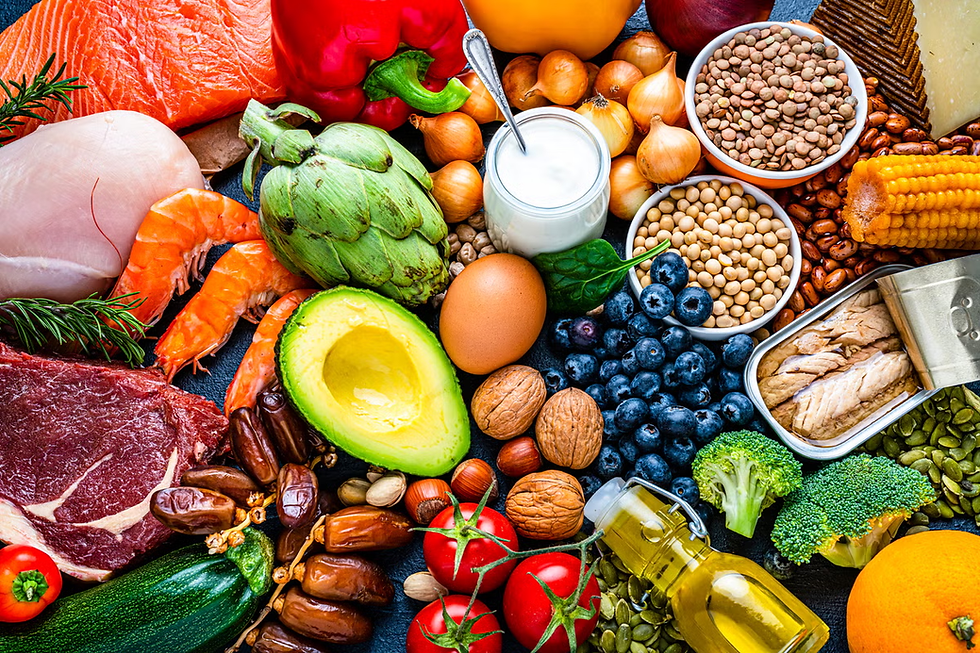Food: Small Wins, Big Impact: How Consumers Balance Stress, Value & Discovery in Food Shopping
- InsightTrendsWorld

- Aug 19
- 6 min read
Why it is the topic trending: The Shift from Survival to Small Joys
Economic pressures remain strong, but behavior is shifting: Consumers across global markets are still very price sensitive. However, unlike the pandemic-era focus on pure survival and lowest-cost options, shoppers are now consciously creating balance — trading down in essentials while trading up in “little luxuries.”
Emotional shopping is rising: Food and beverage purchases are no longer purely functional. Consumers are using them as emotional tools to reduce stress, boredom, and anxiety. This shift explains why small indulgences like candy, premium snacks, and exclusive beverages are trending even as inflation pinches wallets.
Price messaging fatigue: Retailers have leaned heavily into low-price branding — signage, BOGO deals, and loyalty perks. But constant reminders of economic strain are overwhelming, and shoppers are signaling that they don’t want brands to echo stress back at them.
Discovery as a coping mechanism: The Kearney Consumer Institute’s findings show consumers now crave discovery — new flavors, exclusive items, and rotating products — as a way to find joy and novelty in daily routines.
Overview: The Paradox of Pressure and Pleasure
Consumers are navigating a paradox: on one hand, they need to make their money stretch further; on the other, they are unwilling to abandon life’s small pleasures. The result is a hybrid behavior where shoppers are hyper-conscious of value but equally attentive to the emotional satisfaction of discovery. Convenience stores (c-stores) and grocery retailers are natural beneficiaries, as they offer impulse-driven indulgences that can be curated into affordable, joyful “moments.” Successful retailers are those who understand that their role is not just economic relief, but also emotional uplift.
Detailed findings: What the Data Says
Taste outweighs price: 68% of global shoppers prioritize taste in their purchase decisions, showing that flavor and enjoyment drive choice even under financial stress.
Balanced pragmatism dominates: 48% of consumers look for balance — not the lowest price, not the highest quality, but the sweet spot between the two.
Only a minority live at extremes: Just one-third of consumers base decisions solely on price, and only 19% say they consistently seek the highest quality.
Smart, tailored spending: Shoppers want retailers to help them feel intelligent and in control by guiding them toward the “right” products at the “right” time.
No appetite for endless choice: 62% of shoppers believe there are already enough products available. They value edited assortments, where decision-making is simplified, aligning with the models of Aldi, Costco, and Trader Joe’s.
Trend discovery via social media: TikTok and similar platforms are becoming central in shaping demand, pushing food discovery into the cultural zeitgeist.
Key success factors of product discovery: Winning with Small Wins
Curated indulgence over bulk variety: Instead of overwhelming consumers with hundreds of snack SKUs, retailers should emphasize unique, limited assortments that feel special.
Personalized offers: Loyalty programs need to evolve beyond discounts, offering smart, AI-driven suggestions that feel custom-made for shoppers’ preferences.
Exclusive private labels: Store brands that carry emotional equity (e.g., Casey’s chocolate bars, Stewart’s seasonal ice cream) become loyalty drivers.
Rotating seasonal innovation: Shoppers crave novelty but in bite-sized bursts. Seasonal rotations and limited-time exclusives keep the experience fresh.
Impulse-driven emotional design: Placement of indulgent items (snacks, beverages, treats) must be tied to the consumer journey — making joy feel within reach at any purchase moment.
Key Takeaway: A Market of Micro-Indulgence
The modern consumer market is increasingly defined by the pursuit of “micro-indulgences.” People are not abandoning value — but they’re demanding that value include discovery, novelty, and joy. Retailers that continue to only emphasize cost will lose momentum to those who blend savings with meaningful emotional experiences.
Main Trend: The Rise of “Small Wins Shopping”
“Small Wins Shopping” encapsulates consumers’ growing focus on affordable but indulgent experiences that allow them to feel joy without financial guilt. It reflects a broader societal movement toward emotional resilience, where little moments of pleasure — a premium candy bar, a TikTok-inspired drink, or a seasonal donut — provide stability and optimism amid stress.
Description of the trend: Small Wins Shopping
This trend captures how consumers now curate their spending: cutting back in big-ticket areas while deliberately allocating budget to affordable, joyful treats. It is both rational (smart spending) and emotional (momentary relief). It aligns with behavioral economics theories of “mental accounting,” where consumers justify indulgences as offset by broader savings.
Key Characteristics of the Core trend: Micro-Indulgence Meets Smart Value
Affordable pleasure as necessity: Indulgence is no longer frivolous — it’s part of stress management.
Tighter curation = higher loyalty: Shoppers reward retailers who edit assortments and remove decision fatigue.
Exclusive = desirable: Limited or private-label products tap into FOMO while ensuring affordability.
Impulse treated as strategy: Small wins are not accidents; consumers justify and plan them.
Digital discovery ecosystem: TikTok trends create real-time demand for products.
Market and Cultural Signals Supporting the Trend: Shopper Shift
Inflation normalization: Consumers are adapting to high prices rather than resisting them outright.
Private label renaissance: Store brands are no longer “cheap substitutes” but premium alternatives.
Food-as-content culture: TikTok food challenges and viral recipes redefine discovery.
Experience over abundance: Aldi/Costco-style models prove less is more in assortment.
Hybrid indulgence model: Retailers merging foodservice with retail (e.g., BP’s donuts) create competitive advantage.
What is consumer motivation: Seeking Relief in the Everyday
Stress reduction: A small indulgence can offset workplace stress or financial pressure.
Validation of intelligence: Personalized offers reassure consumers they’re “smart shoppers.”
Taste-first joy: Flavor elevates the buying experience beyond mere necessity.
Quick reward loop: C-stores fit the modern lifestyle need for instant gratification.
What is motivation beyond the trend: Identity & Belonging
Cultural belonging: Following food trends fosters social connection.
Personal validation: Discovery builds self-identity as someone who is “in the know.”
Exploration mindset: Curiosity drives the urge to try new flavors and formats.
Emotional control: Smart indulgences help consumers reclaim control in chaotic times.
Descriptions of consumers: The Stressed Explorer
Consumer Summary: Today’s food shoppers are pragmatic explorers. They live under constant financial pressure, but refuse to abandon joy. They are digitally connected, socially influenced, and rely on retailers to balance both economic realities and emotional needs.
Deeper Profile:
Who are they? Pragmatic but curious shoppers balancing survival with discovery.
Age: Primarily 18–45 (Gen Z and Millennials leading digital discovery; Gen X joining for value + treats).
Gender: Both, with women often driving household shopping; men leaning on c-stores for impulse snacks.
Income: Middle to lower-middle class most engaged, though upper-income consumers also chase value in indulgences.
Lifestyle: Stress-heavy, time-poor, and digitally connected; indulges in treats as stress relief and cultural engagement.
How the Trend Is Changing Consumer Behavior: Discovery as Relief
Selective trade-offs: Willing to downgrade in basics to upgrade in small luxuries.
Social-first shopping: Food discovery increasingly starts on TikTok/Instagram.
Preference for editing: Minimalist retail models feel modern and reassuring.
Loyalty-as-relationship: Programs shifting from transactional to personalized engagement.
Impulse reframed: No longer irrational; positioned as rational, affordable joy.
Implications of Trend Across the Ecosystem: Ripple Effects
For Consumers: More empowered, emotionally satisfied, and less overwhelmed in decision-making.
For Brands/CPGs: Must innovate around flavors, exclusivity, and co-branded experiments.
For Retailers: Balancing affordability with discovery is essential; private label becomes a loyalty anchor.
Strategic Forecast: The Future of Small Wins Shopping
Hyper-personalized promotions: Loyalty apps using AI to predict “right indulgence, right time.”
Private-label sophistication: More premium but affordable exclusives under store brands.
Foodservice as loyalty driver: Signature items become emotional anchors for retailers.
Social commerce acceleration: TikTok-driven product launches embedded into retailer strategy.
Decision-simplification retailing: Growth of curated, minimal SKU environments.
Areas of innovation: Joy-Driven Retail
Flavor Exploration: Global/seasonal innovations in snack and beverage categories.
Exclusive Retailer Partnerships: Collabs that generate buzz and exclusivity.
Smart AI Personalization: Promotions tied to individual buying patterns.
Foodservice Fusion: Retailers offering signature items as differentiators.
TikTok-to-Shelf Integration: Using social trends as rapid innovation pipelines.
Summary of Trends
Core Consumer Trend: Small Wins Shopping — balancing stress with affordable joy.
Core Social Trend: Social Discovery — cultural food inspiration spreading through TikTok.
Core Strategy: Curated Indulgence — edited assortments + personalization over abundance.
Core Industry Trend: Private Label Expansion — exclusivity as a loyalty engine.
Core Consumer Motivation: Smart Escape — indulgence framed as both rational and emotional relief.
Final Thought: “Joy Is the New Currency”
The new economy of consumer behavior isn’t just measured in dollars saved, but in joy delivered. Consumers are rewriting the rules of value — demanding that brands and retailers deliver not only affordability but also emotional richness through small, indulgent, and curated experiences. The winners of tomorrow’s retail landscape will not simply lower prices; they will master the art of making consumers feel both smart and joyful in every purchase moment.





Comments